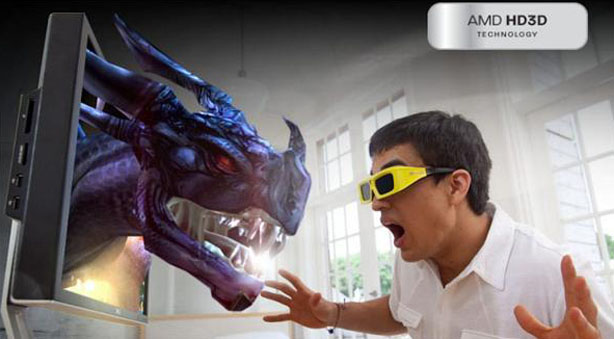AMD HD3D Demo
If you send stereo 3D frames from the display link over the graphics card using industry-standard frame marking, then the display can always take that information and know which frames are for the left eye and the right eye.With 3DTVs, there's also no requirement for Nvidia's glasses anymore, because the glasses are coupled with the display. So what Nvidia's doing to get its GPUs working on 3DTVs is charging $45 for the HDMI 1.4a middleware component. For us, all the stuff you need comes in our regular Catalyst drivers. To enable HD3D gaming on 3DTVs you need to buy the 3D gaming middleware software, and right now that costs $20-$25, so it's a whole lot cheaper. Most calculations of the total cost of ownership point to us as having the most affordable 3D setup.
AMD's Shane Parfitt demonstrates how easy it is to set up HD3D for gaming
BT: So you mainly handle 3D gaming via middleware, but how do you handle 3D movie formats, such as Blu-Ray 3D?
SP: On the 6000 series we actually do a full hardware decode for Blu-Ray 3D using the new unified video decoder (UVD). It's been updated to support multi-view codec (MVC), which is kind of an extension of H.264. The benefit of using this rather than software is a much lower CPU load, lower power and so on. We can also support conversion of normal 2D video to 3D if the software allows it, although this can be a mixed experience – sometimes it looks good, sometimes it doesn't – Blu-Ray 3D is the best option, as the films are made with 3D in mind.
BT: One advantage of 3D Vision is that everything you need, apart from the display, comes in the box. Your system is a little more complicated with the requirement for third-party middleware. How will inexperienced people know how to set it up?
SP: People say that a 3D gaming PC is hard to set up, and we really want to demystify that, because it's really not that hard – you just need a compatible player, a compatible graphics card and a compatible display. We've actually put out a video that shows you can set up HD3D in 60 seconds.
We're also announcing an HD3D hardware certification programme, with an HD3D test plan for displays. Manufacturers can run these tests with our hardware and graphics driver to make sure their display offers a good experience for end users, and that it interoperates well with our hardware. We're working towards having a list of HD3D displays on our website, but right now most HDMI 1.4a displays should work. This is just an extra certification programme where our end users can go and see the various display manufacturers that have partnered with us.
BT: What's the difference between the silver and gold AMD HD3D certification logos?
SP: It's basically the same test plan, but the silver one is like a self test where the display manufacturers run our test plan at their location, and we audit it. The gold one is for when they actually send displays to us, and we run the test plan – the tests are the same, but with the gold badge we've actually tested it at AMD.
 Look out for the AMD HD3D logo, and for dragons
Look out for the AMD HD3D logo, and for dragonsUsing HD3D
AMD demonstrates the HD3D setup to us in our labs with a standard 40in Samsung 3DTV. It genuinely isn't hard to set up the hardware, and the system is up and working in a matter of minutes, including unboxing the hardware. The demo system is setup with the DDD middleware for gaming, which uses profiles for games. However, here are some notable omissions in the list of profiles already in the system, including recent games such as Crysis 2 and Dawn of War II: Retribution, but there are more profiles available online.
You also have to point the middleware at your game's EXE file in order to get it to work, much like a custom driver profile. This is fine for anyone who's familiar with PCs, but it could prove to be a barrier to mainstream take-up as it complicates the process.
We try out the system with Dragon Age II: Origins, and it works surprisingly well. The DDD middleware also allows you to adjust the depth of the 3D effect in the game, as well as plenty of other settings, and the game's characters stand out vividly against the background.
AMD also demonstrates the potential for using the technology in apps such as Google Earth, where the New York skyline was brought to life using the 3D setup. The 3D effect looks unpleasant when you start off, as there's a lot of text and a lot of details that jump out and make the screen look messy. However, the effect looks great once you get down to street level and start looking at the scenery.

MSI MPG Velox 100R Chassis Review
October 14 2021 | 15:04









Want to comment? Please log in.